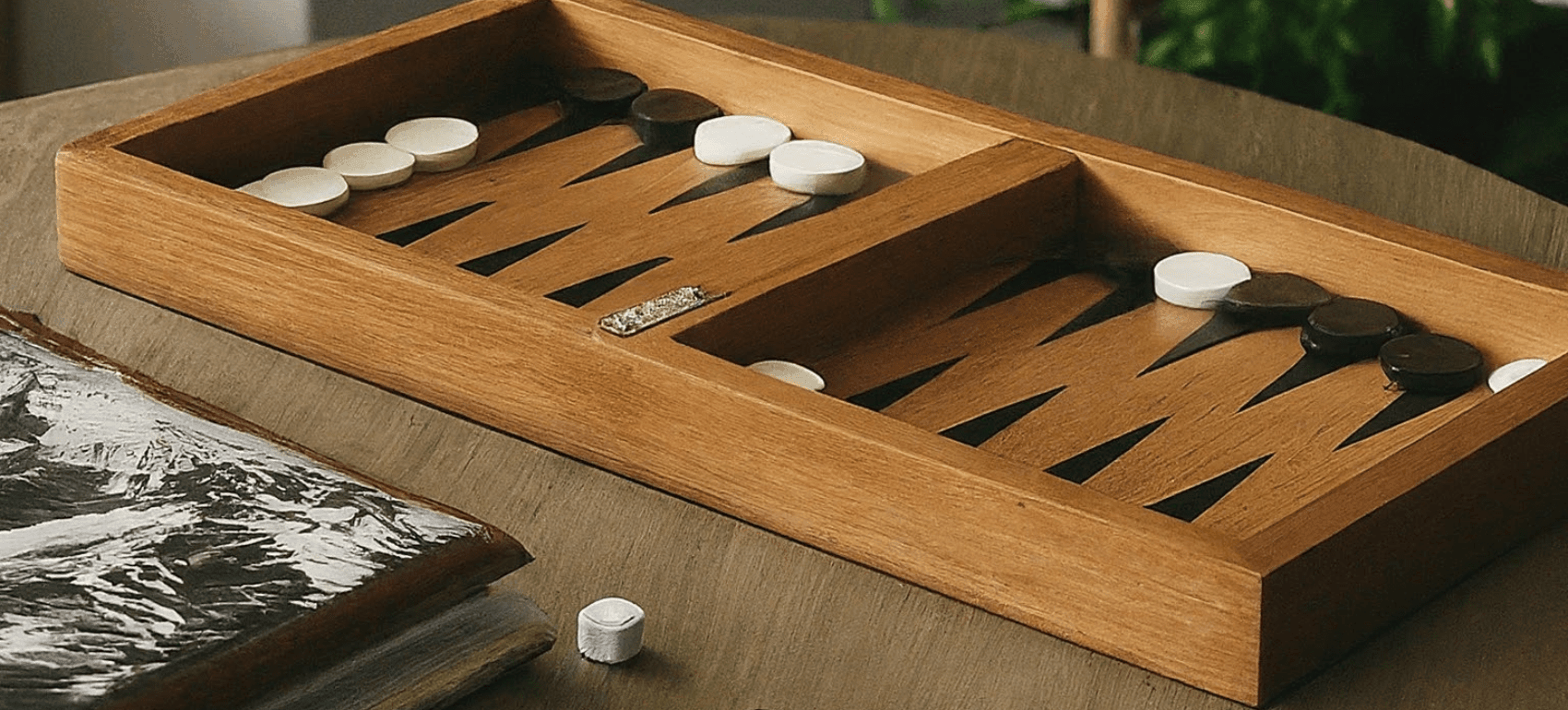
Rolling to Victory: An Ultimate Guide for Backgammon Newbies
Introduction to Backgammon: Understanding the Basics
Backgammon is a timeless board game, as engaging and strategic as a set of wooden chess pieces art 809125, and traces its origins back thousands of years. Played with a combination of luck and skill, it appeals to a diverse array of players, from casual enthusiasts to seasoned tacticians. At its essence, Backgammon is a contest between two opponents who vie for victory by moving their pieces according to the roll of the dice, with the ultimate aim of removing all their pieces from the board before their opponent does.
To start the journey toward backgammon proficiency:
- First, one must familiarize oneself with the Backgammon board, which is divided into four quadrants, each containing six triangular points or ‘spears’.
- Each player begins with fifteen checkers, akin to a set of large wooden chess pieces, which they will move in opposing directions over these points.
- The roll of two dice determines how far a player can move their checkers on any given turn.
- Additionally, players must understand the fundamental tactics such as hitting and blocking, which involve strategically landing on the same point as an opponent’s single checker, or creating a sequence of occupied points that the opponent cannot pass.
- Much like selecting luxury chess pieces, choosing one’s Backgammon set can be a personal statement. For aficionados, a beautiful chess pieces gift for dad may parallel the joy of gifting an exquisite Backgammon set to a fellow enthusiast.
While Backgammon may appear daunting at first glance, with practice, players can quickly grasp the basic principles, such as the starting position of checkers, the significance of the ‘bar’ and the ‘bear-off’ process, leading to a more nuanced understanding and appreciation of this classic game. As one progresses, the game reveals layers of depth, strategy, and excitement that can provide a lifetime of entertainment and challenge.
Backgammon Board Layout: A Visual Guide to the Game
The backgammon board, with its distinctive 24 narrow triangles known as points, is instantly recognizable. These points are grouped into four quadrants of six, often in alternating colors for clear visibility. The quadrants are referred to as the player’s home board and outer board, and the opponent’s home board and outer board.
The points are numbered for each player, starting in that player’s home board. These numbers are crucial for movement within the game. A vertical ridge called the bar bisects the board, separating home and outer boards and serving as the space for hit checkers to re-enter the game.
Each game starts with a precise setup: each player has two checkers on their 24-point, five on the 13-point, three on the 8-point, and five on the 6-point. This layout is mirrored on the opposite side for the opponent. It’s essential for beginners to memorize this setup as it’s the foundation for all backgammon play.
In addition to the checkers, the game features a pair of dice, a doubling cube with numbers 2, 4, 8, 16, 32, and 64, and two dice cups. The dice control the movement of the checkers across the points on the board. The doubling cube is an advanced tool used to keep track of the stakes of the game.
While the classic backgammon set is elegant in its simplicity, some opt for a touch of luxury. For enthusiasts looking to elevate their game, options such as a set of large wooden chess pieces or luxury chess pieces can enhance the tactile experience. Beautiful chess pieces can also serve as a unique gift for dad or any lover of classic board games. These sets, much like the revered art 809125, infuse the timeless game with a sense of sophistication and ceremony.
Pieces and Pips: Familiarizing Yourself With Checkers and Points
In the refined game of backgammon, one must acquaint themselves with two critical components: the checkers and the points on the board. Unlike a set of wooden chess pieces art 809125, backgammon utilizes a total of 30 checkers, sometimes referred to as stones, with each player commanding 15. These checkers are not akin to a set of large wooden chess pieces; rather, they are typically uniform, round, and flat discs. Selecting these pieces could be akin to choosing luxury chess pieces, as they come in various materials, from wood to plastic to marble, each adding an aesthetic and tactile pleasure to the game.
The checkers move along the board’s 24 narrow triangles, known as points. The arrangement of points can be visualized as four distinct quadrants, each comprising six points. The quadrants are called the home and outer boards for each player. Learning the layout is as essential as it is for a chess player to know the importance of beautifully carved chess pieces from a gift for dad set.
When it comes to the initial placement, each point is assigned a specific number of checkers. Unlike chess, where each piece moves differently, all checkers in backgammon move according to the roll of the dice, yet strategies abound in the calculation of risk and reward with each potential move.
The deployment and advancement of these pieces aim to bring them all into one’s own home board and then to bear them off the board, a process best done with strategic forethought. Victory hinges not only on the roll of the dice but on the skillful maneuvering of one’s checkers in response to the changing battlefield marked by pips and points. To master this game, one must combine the luck of the roll with a tactician’s precision, treating each checker not as just a casual disc but as a crucial foot soldier in the fight for backgammon dominance.
Rolling the Dice: The Mechanics of Starting Play
At the outset of a Backgammon game, the initial roll of the dice determines which player goes first. This essential step sets the entire course of play into motion, akin to the opening move of a chess match. Picture a set of wooden chess pieces artfully arranged; this is the moment the game transitions from poised potential to dynamic progression.
To begin, both players roll a single die. It is paramount for fairness that these dice are identical in weight, size, and shape. The player with the higher number on their die initiates the game. If both players roll the same number, they must roll again, maintaining the equitable nature of the game’s commencement.
Once a player has taken the first turn, that individual rolls both dice and proceeds with their move. Contrary to the single die roll, this time the numbers on the two dice serve as separate moves. For example, if a player rolls a 3 and a 5, they may move one checker three spaces and another checker five spaces, or they may decide to move a single checker a total of eight spaces.
If the dice roll out of the playing surface or land on top of the checkers, the roll is deemed invalid and must be repeated. This ensures the integrity of each player’s move, reflecting the serious nature of competitive play.
In this pivotal moment, similar to selecting a luxury chess piece during a game of stratagem, the player must consider their options and plan their opening gambit. Whether it’s a considered approach mirrored by the selection of beautiful chess pieces, or the ambitious strategy one might reserve as a gift for a backgammon enthusiast dad, the roll of the dice is where anticipation turns to action.
Movement Strategies: How to Move Your Checkers Effectively
Effective checker movement in backgammon is as strategic as a set of wooden chess pieces artfully maneuvering across the board. For backgammon enthusiasts, mastering this aspect can make the difference between a triumphant victory or a humbling defeat.
Understand the Basics: Before contemplating sophisticated strategies, ensure you have a firm grasp on the basic rules of checker movement. Each roll of the dice represents the potential moves of your checkers across the 24 points on the board, towards your home quadrant.
Create a Flexible Game Plan: Adopting a flexible approach can be as beneficial as owning a set of large wooden chess pieces. While you may start with a strategy, the nature of dice-driven games means you should be ready to adapt based on the rolls you receive.
Build a Strong Home Board: Strive to fortify your home board early on, which is akin to positioning luxury chess pieces in a defensive stance. This can block your opponent’s checkers and pave the way for a potential victory.
Avoid Single Checkers: Leaving a checker by itself (a blot) is a risky move. It’s like having a lone king exposed in chess—a gift for dad who’s a strategy enthusiast to knock out. Aim to keep your checkers paired to avoid them being captured.
Consider the Doubles: Rolling doubles with dice can be a game-changer, offering the opportunity to move four checkers instead of two. Beautiful chess pieces moving in unison can control the game board; likewise, moving multiple checkers together in backgammon can be a formidable strategy.
Hit and Block: Playing offensively by hitting your opponent’s blots can send their checker back to the bar, while strategically placed checkers can block your opponent’s progress. Like chess, it’s about balancing attack and defense.
Escape With Your Back Checkers: Ensure your back checkers advance towards your home board as soon as feasible to avoid them getting trapped behind a barricade of your opponent’s checkers.
By applying these strategies effectively, novices can quickly learn to move their checkers with the proficiency of a seasoned backgammon player, turning the tide in their favor with each throw of the dice.
Hitting and Entering: Mastering Offensive and Defensive Plays
In the strategic realm of backgammon, where a set of wooden chess pieces may inspire elegance and mental rigor, mastering the offensive and defensive maneuvers of hitting and entering becomes vital. Adept players know that these tactics are as crucial to success as the exquisite craftsmanship of large wooden chess pieces is to the aesthetic of chess.
For the offensive, hitting an opponent’s blot—a single checker resting on a point—is aggressive play. This move sends the checker to the bar, placing the opponent at a disadvantage and potentially altering the game’s dynamics significantly. Not only does this force the opponent’s next roll to focus on re-entry, but it can also open up opportunities to secure points or build barricades.
On the defensive end, skilled entry of checkers from the bar is equally vital. When a checker is hit and placed on the bar, re-entering the board at the earliest opportunity is essential. This entails rolling dice numbers that correspond to points not occupied by two or more of the opponent’s checkers. Successful re-entry can reinvigorate one’s game position and enable further strategic plays.
Additionally, players must balance these offensive and defensive plays within the scope of the overall game. It is not enough to focus solely on beautiful chess pieces or the luxury of large chess sets; backgammon demands the ability to pivot between attacking and defending. Each move requires careful consideration, anticipating opponents’ responses, and the long-term impact on one’s position.
Players vying for victory must not underestimate these cornerstone tactics. Remember, every hit and well-timed re-entry could be the difference between triumph and defeat—mirroring the thoughtfulness that goes into selecting the perfect gift for dad in the form of a luxury chess set, the right offensive and defensive plays in backgammon are gifts to one’s strategic prowess.
Doubling Down: Utilizing the Doubling Cube in Gameplay
In the sophisticated world of backgammon, the doubling cube is a powerful tool that can quickly escalate the stakes of a match. Unlike a set of large wooden chess pieces, which have pre-assigned values and moves, the doubling cube emboldens players to assert their confidence in their position during the game. To leverage this instrument effectively, one must understand its tactical nuances and their implications on the gameplay.
The doubling cube is not just a die but a marker of the game’s stakes, with its faces numbered 2, 4, 8, 16, 32, and 64. Its introduction is a declaration that a player believes they have a strong enough advantage to double the points at stake. However, this move entails risks and rewards:
Risk Assessment: Before utilizing the doubling cube, analyze the board carefully. Weigh your advantage against possible countermoves, just as you would consider the strategic position of luxury chess pieces on a chessboard.
Timing: The cube is often introduced when a player gains a significant lead. It’s a strategic weapon, representing not only the doubling of the current stakes but also dictating the flow of the game henceforth.
Psychological Warfare: Introducing the doubling cube puts psychological pressure on the opponent, akin to making a bold move with a beautiful chess piece that shifts the dynamic of a chess game.
Cube Acceptance: When the cube is offered, the opponent has the choice to accept the double and continue play or to concede the game at the current stakes.
Cube Ownership: Once the opponent accepts the double, they take ownership of the cube and reserve the right to redouble the stakes later in the game, which can turn the tides dramatically.
Players should treat the doubling cube as they would a gift for dad—cherish it, use it wisely, and recognize its potential to profoundly impact the board. Mastery of the doubling cube can be a game-changer, turning a novice into a seasoned competitor.
Bearing Off: The Final Stretch to Victory
In the enthralling game of backgammon, mastering “bearing off” is crucial for claiming victory. This process begins once a player has moved all of their checkers into their home board. At this final stage, the player will roll the dice and remove the checkers from the board, simulating a set of wooden chess pieces artfully exiting the battlefield. However, specific rules govern this crucial phase.
- Players must bear off checkers by rolling a number that corresponds to the point on which the checker resides. For example, rolling a four allows a player to remove a checker from the four point.
- If there are no checkers on the point indicated by the roll, the player must make a legal move using a checker on a higher-numbered point. If there are no checkers on higher-numbered points, the player must bear off a checker from the highest point that has a checker.
- Strategy is key during bearing off. While it may be tempting to remove checkers as quickly as possible, players must also consider the risk of leaving checkers vulnerable to being sent back by the opponent’s checkers.
- Opposing checkers that land on a blot during bearing off can substantially alter the momentum of the game. Hence, it’s important to anticipate potential counter-moves from the opponent and maintain a balance between swift bearing off and defensive positioning.
- The first player to remove all their checkers from the board is the winner, elevating a set of large wooden chess pieces – luxury chess pieces, if you will – into a triumphant stance.
- Remember, thoughtful bearing off can be the difference between a win and a loss. Each move should be deliberate, like placing beautiful chess pieces onto a board, culminating in a satisfying victory, possibly even making it a memorable gift for dad on a special occasion.
The culmination of a backgammon game mirrors the poised approach of a learned chess player, with each movement of the checkers increasingly weighted with the anticipation of victory. The parallel with chess is undeniable—bearing off is akin to a careful endgame strategy, where each decision can be pivotal. As newbies develop this endgame foresight, they learn that the true art of backgammon lies not just in advancing checkers, but in gracefully retiring them from the board.
Common Mistakes and How to Avoid Them
Backgammon, while sharing a familial resemblance with chess due to its strategy elements and often beautifully crafted game sets, presents its own unique challenges. Players new to backgammon, who may have previously enjoyed a set of wooden chess pieces art 809125, can sometimes find transitioning their strategic thinking to backgammon a bit daunting. Here are common backgammon pitfalls and tips on how to steer clear.
Not Doubling Aggressively Enough: Many newcomers are too conservative with the doubling cube. This hesitation can cost valuable points. Learn to assess the board and double when you have a solid advantage.
Overlooking the Power of the Builder: Beginners tend to focus on moving checkers around the board but neglect the strategy of building new points. Positioning your checkers to create additional anchor points is a fundamental tactic.
Failure to Balance Offense and Defense: Striking a balance between attacking your opponent and fortifying your positions is crucial. Do not focus solely on bearing off your pieces; make sure to also disrupt your opponent’s game.
Ignoring Backgame Strategies: A common mistake is giving up too soon. Even if you’re behind, a well-timed backgame can turn the tides. Understand when and how to switch to a backgame strategy.
Neglecting to Secure Blots: Unprotected single checkers, or blots, are vulnerable. Always be mindful of leaving blots, especially when your opponent has checkers on the bar or in your home board.
To avoid these missteps, practice consistently and review each game to understand your errors. Backgammon is a blend of risk and skill, similar to contemplating moves with large wooden chess pieces. Luxury chess pieces may double as elegant decor, but in backgammon, every piece has the potential for victory. It’s not just a beautiful chess pieces gift for dad; it’s a trove of strategy for the keen-minded player.
Etiquette and Fair Play: Rules for Respectful Gaming
Whether you are setting up a set of wooden chess pieces art 809125 or engaging in a competitive game of backgammon, maintaining etiquette and demonstrating fair play are paramount. Engaging in sportsmanlike conduct isn’t just about politeness; it fosters a more enjoyable and respectful gaming environment for everyone involved. Here are some fundamental rules to ensure respectful gaming as you learn the ropes of backgammon:
Begin with a Polite Introduction: Just as a set of large wooden chess pieces conveys a sense of dignity and grace on the chessboard, your demeanor should reflect respect towards your opponent. A simple greeting and a handshake before the match can set a positive tone.
Understand the Rules: Familiarize yourself with the backgammon rules thoroughly. Not only does this prevent misunderstandings, but it also shows that you value the game and your opponent’s time.
Handle Equipment with Care: Treat the backgammon board and pieces with the same respect as luxury chess pieces. Whether they are beautifully crafted or simple, these are tools of the trade and should be handled gently.
Timely Moves: Make your moves promptly. Deliberate time-wasting is poor sportsmanship and saps the enjoyment out of the game.
Compliment Good Play: Acknowledge your opponent’s skillful moves. A compliment can be as rewarding as giving a set of beautiful chess pieces as a gift for dad on a special occasion.
Keep a Lid on Emotions: Winning is thrilling, but boasting can be unpleasant for your opponent. Likewise, gracefully accept losses without displaying anger or making excuses.
Respect the Spectators: If others are watching, be mindful of your language and behavior. They are part of the gaming experience and deserve consideration.
No Distractions: Avoid creating disturbances like checking your phone constantly or engaging in side conversations.
Post-Game Etiquette: Win or lose, close the game with a handshake and thank your opponent for the game.
By adhering to these simple rules of etiquette and fair play, you ensure that the game remains enjoyable and dignified, much like a thoughtful game of chess with a treasured set.
Advanced Strategies: Tips for Taking Your Game to the Next Level
Backgammon, much like chess, demands acute strategic thinking. With that in mind, imagine complementing your gameplay with a set of large wooden chess pieces, radiating the gravitas of the game. These luxury chess pieces not only serve as a metaphor for Backgammon’s complexity but also act as an inspiration, urging players to think more deeply about their strategy.
Advancing in Backgammon requires more than understanding the basic rules and concepts; one must dive into the intricacies of the game. Here are some expert tips to enhance your skills:
- Doubling Cube Dynamics: Grasping the power of the doubling cube is pivotal. Use it proactively to pressure your opponent, but also know when to accept or decline a double. It’s a dance of risk and reward, much like choosing a beautiful chess piece for a critical move.
- Prime Versus Blitz: Focus on building a prime, a consecutive series of blocked points, while also keeping an eye on the opportunity to blitz — aggressively attacking your opponent’s lone checkers.
- Flexibility Over Commitment: Strike a balance between establishing points and keeping your checkers mobile. Much like how you would contemplate a move with a cherished gift for dad – a set of wooden chess pieces art 809125 – always think several moves ahead in Backgammon.
- Avoid Stacking: Like spreading out your chess pieces for better board control, spread your checkers in Backgammon to cover more points.
- Endgame Excellence: The bear-off phase is where games are won or lost. Have a clear strategy on how you’ll remove checkers from the board when the time comes.
Ingrain these strategies into your gameplay, as if they were as tangible and graceful as a luxury chess piece in your hand. Elevate your game from the foundational moves to masterful play worthy of victory.
Backgammon Resources: Books, Online Tutorials, and Clubs
Eager to master the strategies of Backgammon, enthusiasts may find a wealth of resources at their disposal. These include instructional books, engaging online tutorials, and interactive club environments. Here’s a curated list to help individuals on their journey from novices to seasoned players:
Books
Individuals who prefer traditional learning methods can delve into a variety of books accompanying their set of large, wooden chess pieces. Key titles include:
- “Backgammon for Winners” by Bill Robertie: This book offers a clear and comprehensive introduction, making it ideal for beginners.
- “Backgammon for Dummies” by Chris Bray: An accessible guide for understanding the basics and nuances of the game.
- “Backgammon to Win” by Chris Bray: A more advanced book that explores intricate strategies and tactics.
Online Tutorials
Online Backgammon tutorials have become a quintessential tool for players of all levels. These resources offer interactive and visual guidance:
- Backgammon Galaxy: It provides tutorials for beginners and advanced strategies for more experienced players.
- YouTube Channels: Channels such as BackgammonHUB offer a trove of instructional videos, from the basics to advanced techniques.
Clubs
Joining a Backgammon club can significantly enhance one’s learning curve. Clubs provide the opportunity to play against various opponents, gain insight from seasoned players, and participate in tournaments. Beginners can find local clubs or online communities where they can showcase those beautiful chess pieces, a perfect gift for dad, with other aficionados. Consider:
- Local community centers or gaming shops: Often host Backgammon nights or have in-house clubs.
- Meetup.com: A place to find local Backgammon groups and upcoming events.
- Play65 and DailyGammon: Online platforms where one can join virtual clubs and compete against players from around the world.
A combination of these resources can equip Backgammon players with the skills and strategies needed to excel in the game. Whether it’s through the time-honored advice found in books, the modern convenience of online tutorials, or the dynamic practice provided by club memberships, there’s no shortage of avenues to explore.
Wrapping Up: Recap and Next Steps for Aspiring Backgammon Players
In embarking on the journey of mastering backgammon, novices have now been versed in the essentials of gameplay, strategic approaches, and the subtleties of probability and risk management. To wrap up, let’s recapitulate and outline the next steps for those eager to refine their backgammon prowess.
- Review the Basics: Re-familiarize yourself with the objectives, setup, and movement rules. Just as learning to arrange a set of wooden chess pieces art 809125 is fundamental before a chess match, understanding the backgammon board setup is crucial.
- Practice: Solidify your grasp of the opening moves, bearing off, and the use of the doubling cube. Make practice a regular routine, much like how a set of large wooden chess pieces are repeatedly employed to perfect various strategies.
- Advanced Strategies: Deepen your strategic understanding. Study positional play, consider holding and backgame tactics, and practice utilizing the beautiful chess pieces of backgammon – your checkers – to tactfully block and hit.
- Play with Others: Engage in games with players of varying skill levels. Analyzing their moves can be as instructive as gift for dad on a special occasion – invaluable experience that enhances your own game.
- Self Analyze: Reflect on your games, identifying strengths and weaknesses. Use online resources and software that can help dissect your play style.
- Compete: Once confident, enter local clubs, online tournaments, or casual competitions. Embrace the luxury chess pieces’ mentality where every move is a chance to excel.
- Continual Learning: Immerse yourself in backgammon literature and online forums. Seek out advanced concepts and diversify your knowledge just like the assortment of luxury chess pieces offer a variety of tactical decisions.
With these steps, the aspirants are equipped not just to enjoy backgammon but to become formidable players who command the board with strategy, grace, and finesse.






